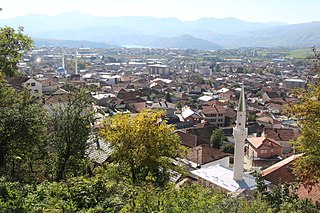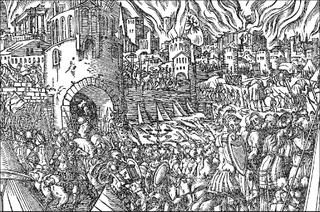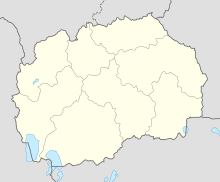
Debar is a city in the western part of North Macedonia, near the border with Albania, off the road from Struga to Gostivar. It is the seat of Debar Municipality. Debar has an ethnic Albanian majority of 74% and is North Macedonia's only city where ethnic Macedonians do not rank first or second demographically. The official languages are Macedonian and Albanian.

The League of Lezhë was a military and diplomatic alliance of the Albanian aristocracy, created in the city of Lezhë on 2 March 1444. The League of Lezhë is considered the first unified independent Albanian country in the Medieval age, with Skanderbeg as leader of the regional Albanian chieftains and nobles united against the Ottoman Empire. Skanderbeg was proclaimed "Chief of the League of the Albanian People," while Skanderbeg always signed himself as "DominusAlbaniae".

Moisi Golemi, also known as Moisi of Dibra, was an Albanian nobleman and a commander of the League of Lezhë. In 1443–44 he captured all Ottoman holdings in the area of Dibër region. For a brief period in the 1450s he joined the Ottomans, but soon abandoned them and returned to the League. He died in 1464, when he was executed publicly in Constantinople after being captured by the Ottoman army.

The siege of Berat took place in July 1455 when the Albanian army of Skanderbeg attempted to capture the fortress in the Albanian city of Berat, which was held by Ottoman forces. The attempt resulted in a failure when an Ottoman relief army arrived and routed the besieging forces.

The Battle of Albulena, also known as the Battle of Ujëbardha, was fought on 2 September 1457 between Albanian forces led by Skanderbeg and an Ottoman army under Isak bey Evrenoz and Skanderbeg's nephew, Hamza Kastrioti.
Ballaban Badera was an Ottoman military officer from Albania. A conscript of the Devshirme system, he became a Pasha. Ballaban Badera was said to be the first climbing the walls of Constantinople. He held a position of sanjakbey of the Sanjak of Ohrid in 1464 and 1465.

Gjergj Arianiti (1383–1462) was an Albanian feudal lord who led several successful campaigns against the Ottoman Empire. He was the father of Donika, Skanderbeg's wife, as well as the grand-uncle of Moisi Arianit Golemi. Gjergj Arianiti was Skanderbeg's ally within League of Lezhë before abandoneding the alliance after the defeat in Berat in 1450. He later returned. Robert Elsie emphasizes that Arianiti was often Skanderbeg's rival. He allied with the Kingdom of Naples in 1446, left his alliance with Skanderbeg by 1449 and allied with Venice in 1456. However his daughter married Skanderbeg and he remained officially part of the League of Lezhe, continuing to fight Ottomans successfully up to his death in 1462.

The first siege of Krujë occurred in 1450 when an Ottoman army led by Sultan Murad II and his crown prince Mehmed II tried to besiege the Albanian town of Krujë. The League of Lezhë, led by Skanderbeg, experienced low morale after losing Svetigrad and Berat between 1448 and 1450. Nevertheless, Skanderbeg's exhortations and the support of the clergy, who claimed to have had visions of angels and victory, motivated the Albanians to defend the capital of the League, Krujë, at all costs. After leaving a protective garrison of 4,000 men under his trusted lieutenant Vrana Konti, Skanderbeg harassed the Ottoman camps around Krujë and attacked the supply caravans of Sultan Murad II's army. By September, the Ottoman camp was in disarray as morale sank and disease ran rampant. The Ottoman army acknowledged that the castle of Krujë would not fall by strength of arms, lifted the siege, and made its way to Edirne. Soon thereafter, in the winter of 1450–51, Murad died in Edirne and was succeeded by his son, Mehmed II.

Gjergj Kastrioti, commonly known as Skanderbeg, was an Albanian feudal lord and military commander who led a rebellion against the Ottoman Empire in what is today Albania, North Macedonia, Greece, Kosovo, Montenegro, and Serbia.
The Battle of Torvioll, also known as the Battle of Lower Dibra, was fought on 29 June 1444 on the Plain of Torvioll, in what is modern-day Albania. Gjergj Kastrioti Skanderbeg was an Ottoman Albanian general who decided to go back to his native land and take the reins of a new Albanian League against the Ottoman Empire. He, along with 300 other Albanians fighting at the Battle of Niš, deserted the Ottoman army to head towards Krujë, which fell quickly through a subversion. He then formed the League of Lezhë, a confederation of Albanian princes united in war against the Ottoman Empire. Murad II, realizing the threat, sent one of his most experienced captains, Ali Pasha, to crush the new state with a force of 25,000-40,000 men.
The Battle of Vajkal or Battle of Valkal was a battle fought in April of 1465 between the Albanian forces of Skanderbeg and an Ottoman army under Ballaban Pasha, an Ottoman commander of Albanian origin. Ballaban Badera, the new Ottoman sanjakbey of the Sanjak of Ohrid, was sent by Sultan Mehmed II to attack Albanian forces. The Albanians were ultimately victorious, but both sides suffered heavy losses. Some of Skanderbeg's officers were captured by the fleeing Ottomans and were then summarily executed.

The Albanian–Venetian War of 1447–48 was waged between Venetian and Ottoman forces against the Albanians under George Kastrioti Skanderbeg. The war was the result of a dispute between the Republic and the Dukagjini family over the possession of the Dagnum fortress. Skanderbeg, then ally of the Dukagjini family, moved against several Venetian held towns along the Albanian coastline, in order to pressure the Venetians into restoring Dagnum. In response, the Republic sent a local force to relieve the besieged fortress of Dagnum, and urged the Ottoman Empire to send an expeditionary force into Albania. At that time the Ottomans were already besieging the fortress of Svetigrad, stretching Skanderbeg's efforts thin.
The First Battle of Oranik took place during the Albanian-Venetian War of 1447-1448, when the Republic of Venice allied with the Ottoman Empire against the League of Lezhë. The Albanian forces under Skanderbeg defeated the Ottoman army led by Mustafa Pasha during a battle that took place near Oranik of Upper Dibra, and two months later, peace was established between Albania and Venice.

The siege of Svetigrad or Sfetigrad began on 14 May 1448 when an Ottoman army, led by Sultan Murad II, besieged the fortress of Svetigrad. After the many failed Ottoman expeditions into Albania against the League of Lezhë, a confederation of Albanian Principalities created in 1444 and headed by Skanderbeg, Murad II decided to march an army into Skanderbeg's dominions in order to capture the key Albanian fortress of Svetigrad. The fortress lay on an important route between present-day North Macedonia and Albania, and thus its occupation would give the Ottomans easy access into Albania.

The Battle of Polog was the result of an Albanian incursion into Ottoman territory. Aided by Alfonso the Magnanimous, the Albanian leader Skanderbeg made plans to recapture Svetigrad, which had been lost in 1448. His strategy involved launching an invasion of Macedonia to devastate the country surrounding Svetigrad and to lure the garrison into a trap. While implementing this, he was stopped in the fields of Polog near Tetovo by a force which was planning to invade Albania led by his old friend Ibrahim Pasha. The force was quickly destroyed and Skanderbeg's army proceeded its looting before returning to Debar.
On August 1465, Ballaban Badera, a sanjakbey of the Sanjak of Ohrid who was an Albanian-born janissary launched his fourth but largest campaign against Skanderbeg. He was defeated in both battles of Ohrid and Vajkal the year before. Ballaban had previously inflicted severe casualties on Skanderbeg's forces and soon received high favor from Mehmet II. He soon appointed Ballaban and Jakup Arnauti—both Albanian peasants by birth—to lead a joint-campaign against Skanderbeg's forces. According to some scholars, this act of inclusion by the Sultan was a promotion of a social revolution within Albania to wean forces away from Skanderbeg.
The Ottoman invasion of Albania in 1452 was a campaign by the newly acceded Ottoman sultan Mehmed II against Skanderbeg, the chief of the League of Lezhë. Shortly after the first siege of Krujë, Murad II died in Edirne, and was succeeded by his son Mehmed II. Mehmed ordered nearly annual invasions of Albania which often resulted in multiple battles in one year. The first of these expeditions was sent in 1452 under the dual command of Hamza Pasha and Tahip Pasha, with an army of approximately 25,000 men.
The Second Battle of Mokra occurred on July 7, 1462, right before Skanderbeg's Macedonian campaign. Sultan Mehmed II had come out of his recent campaigns victorious, adding large swaths of lands to his domains. He was confident enough to send a new force into Albania to weaken the Albanian forces. He thus sent an army under Sinan bey to complete the job. Skanderbeg had been prepared and moved towards the Albanian frontier. The armies came near Mokra where Skanderbeg had positioned his forces on a mountain dominating the landscape. When the Turkish force got near enough, the Albanians ambushed and the Turks routed. Skanderbeg then raided Macedonia and shared the loot with his men.
This timeline lists important events relevant to the life of the Albanian feudal lord and military commander Gjergj Kastrioti Skanderbeg, widely known as Skanderbeg.

Skanderbeg's rebellion was an almost 25-year long anti-Ottoman rebellion led by the Christian military commander Skanderbeg in what is today Albania and its neighboring countries. It was a rare successful instance of resistance by Christians during the 15th century and through his leadership led Albanians in guerrilla warfare against the Ottomans.













